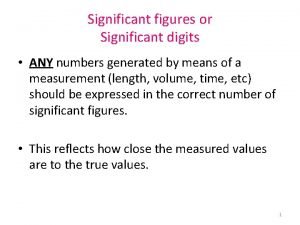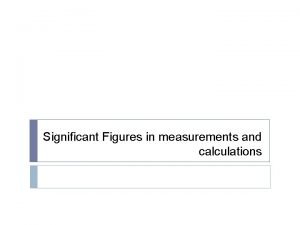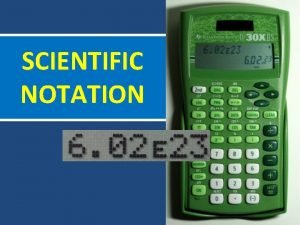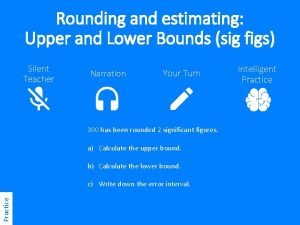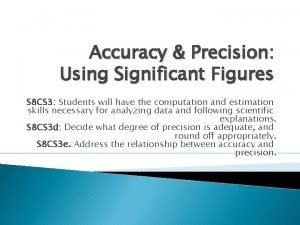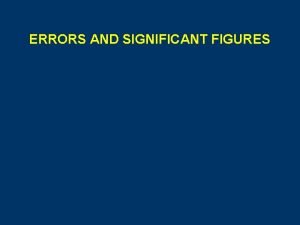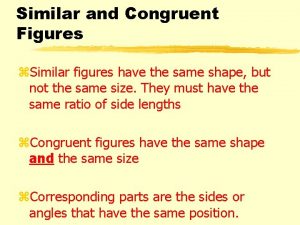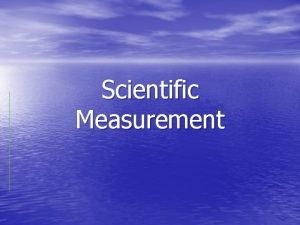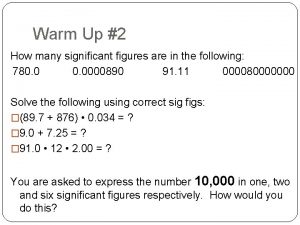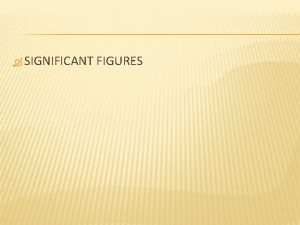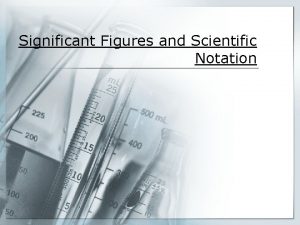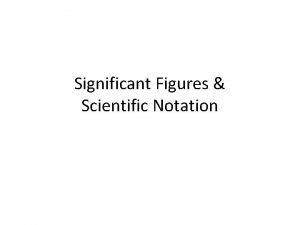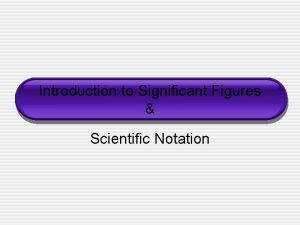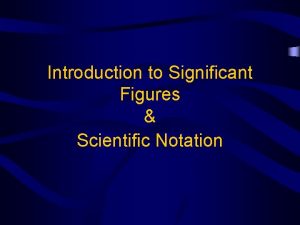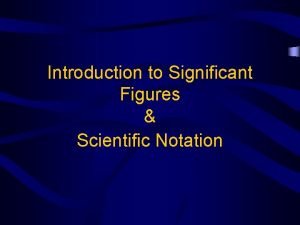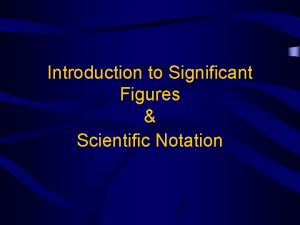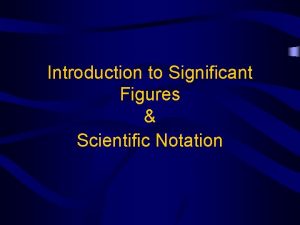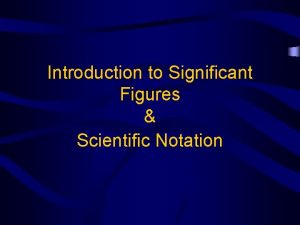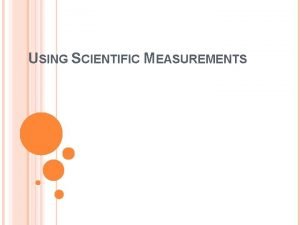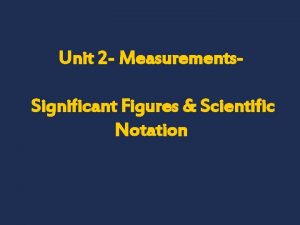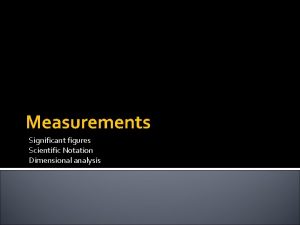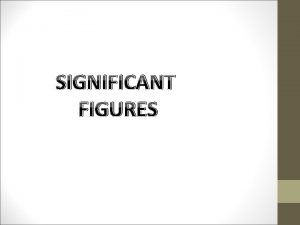Significant Figures Measurements and Scientific Notation Scientific Notation
















- Slides: 16

Significant Figures, Measurements and Scientific Notation

Scientific Notation -- used to express very large or very small numbers, and/or to indicate precision (i. e. , to maintain the correct number of significant figures) Form: (# from 1 to 9. 999) x 10 exponent 800 = 8 x 102 2531 = 2. 531 x 10 = 2. 531 x 103 0. 0014 = 1. 4 10 10 = 1. 4 x 10– 3

Put in standard form. 1. 87 x 10– 5 = 0. 0000187 3. 7 x 108 = 370, 000 7. 88 x 101 = 78. 8 2. 164 x 10– 2 = 0. 02164 Change to scientific notation. 12, 340 = 1. 234 x 104 0. 369 = 3. 69 x 10– 1 0. 008 = 8 x 10– 3 1, 000, 000 = 1 x 109 6. 02 x 1023 = 602, 000, 000, 000

The Atlantic - Pacific Rule for Significant Figures • • When determining the number of significant figures ask the question: “Does the number have a decimal point? ” (YES or NO answer) If YES, then think of “P” for Present and the Pacific ocean If NO, then think of “A” for Absent and the Atlantic ocean

The Atlantic and Pacific Rule for Significant Figures 0. 00125 578, 920, 000 Decimal Present. Count left to right starting at first non-zero. Atlantic Pacific Decimal Absent. Count right to left starting at first non-zero.

The Atlantic and Pacific Rule for Significant Figures • "P" for "Present". This means that we imagine an arrow coming in from the Pacific ocean, from the left side • "A" for "Absent". This means that we imagine an arrow coming in from the Atlantic ocean, the right side.

The Atlantic and Pacific Rule for Significant Figures • Look for the first non zero number starting from that direction • That number, and all other numbers following it are considered to be significant • For “P” the numbers to the right of the first non zero number • For “A” the numbers to the left of the first non zero number

Sig. Figs. Practice Ex 1) 0. 020110 Ex 2) 730800 • 1) 48001 • 2) 9807000 • 3) 0. 008401 • 4) 40. 500 • 5) 64000 • 6) 64000. • 7) 64000. 00 • 8) 0. 0107050

Sig. Figs. Practice Ex 1) 0. 020110 Ex 2) 730800 • 1) 48001 • 2) 9807000 • 3) 0. 008401 • 4) 40. 500 • 5) 64000 • 6) 64000. • 7) 64000. 00 • 8) 0. 0107050 Ex 1) 0. 020110 (5 sig. figs. ) Ex 2) 730800 (4 sig. figs) • 1) 48001 (5 sig. figs. ) • 2) 9807000 (4 sig. figs. ) • 3) 0. 008401 (4 sig. figs. ) • 4) 40. 500 (5 sig. figs. ) • 5) 64000 (2 sig. figs. ) • 6) 64000. (5 sig. figs. ) • 7) 64000. 00 (7 sig. figs. ) • 8) 0. 0107050 (6 sig. figs. )

How many cm are in 1. 32 meters? equality: 1 m = 100 cm (or 0. 01 m = 1 cm) conversion factors: 1 m ______ 100 cm 1. 32 m or ( cm 100 ______ 1 m 100 cm ______ 1 m ) = 132 cm We use the idea of unit cancellation to decide upon which one of the two conversion factors we choose.

How many m is 8. 72 cm? equality: 1 m = 100 cm _ 1 m ______ 100 cm 8. 72 cm or ( 1 m ______ 100 cm ______ 1 m ) = 0. 0872 m Again, the units must cancel.

How many kilometers is 15, 000 decimeters? 15, 000 dm ( )( 1 m ____ 10 dm 1 km ______ 1, 000 m ) = 1. 5 km

How many seconds is 4. 38 days? ( )( 24 h 4. 38 d ____ 1 d 60 min _____ 1 h )( ) 60 s ____ 1 min If we are accounting for significant figures, we would change this to… = 378, 432 s 3. 78 x 105 s

Practice • On your own convert the following measurements: 1. How many inches are there in 45. 6 cm? (There are 2. 54 cm in 1 inch) 2. How many hours are there in 34. 5 years? 3. How many feet are in 5. 3 yards?

Practice • On your own convert the following measurements: 1. How many inches are there in 45. 6 cm? (There are 2. 54 cm in 1 inch) 18. 0 inches 2. How many hours are there in 34. 5 years? 3. 02 x 105 hours 3. How many feet are in 5. 3 yards? 15. 9 feet

Book Problems • Pg. 52 # 37 a-e. Write in scientific notation and count the number of sig figs. # 49 a-e
 Scientific notation significant figures worksheet
Scientific notation significant figures worksheet Sig fig rules
Sig fig rules Sig figs thermometer
Sig figs thermometer Scientific notation
Scientific notation Tera scientific notation
Tera scientific notation Unit 2 lesson 2 scientific notation
Unit 2 lesson 2 scientific notation Upper and lower bounds significant figures
Upper and lower bounds significant figures Upper and lower bound polynomial calculator
Upper and lower bound polynomial calculator Accuracy and precision significant figures
Accuracy and precision significant figures 3 significant figures upper and lower bounds
3 significant figures upper and lower bounds Errors and significant figures
Errors and significant figures Are congruent figures similar
Are congruent figures similar Plane shapes
Plane shapes What is the name of the solid figure
What is the name of the solid figure Scientific measurements
Scientific measurements Is ap chemistry hard
Is ap chemistry hard How many significant figures does 956 have
How many significant figures does 956 have

